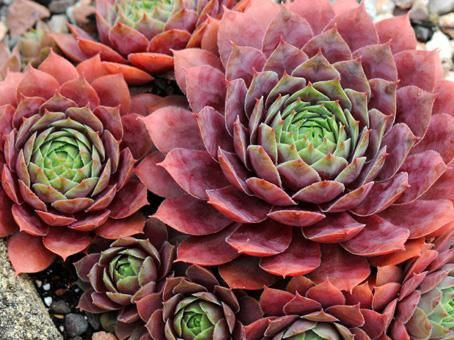Sempervivum ‘Brock’ A strong, large grower with shades of pink and orange that deepen to purple in winter.
It has pointed leaves lined with cilia and produces offsets on long stolons.
Sempervivum Brock needs plenty of outdoor sunlight to show their best colors and maintain a tight rosette form.
They thrive in gritty, well-draining soils and pots with drainage holes.
They produce new offsets or “chicks” on stolons. These chicks can be left to form tidy clusters or removed to share and transplant.
Sempervivum Brock does most of its growth in the spring and summer and will thrive with weekly watering and afternoon shade if temperatures exceed 80F.
They are incredibly frost hardy and will happily overwinter under an insulating blanket of snow.
Protect from heavy rains and standing water to prevent rot.
Tips to take care of the Sempervivum Brock
Substratum
Sempervivum thrives in poor soils.
They don’t even need almost any land to live.
I’ve seen them grow in cracks and rocky walls.
To cultivate this succulent plant, very well-drained soil must be used, either in the form of sandy soil, sand or rocks.
It is very important to have good drainage because succulents are very susceptible to excess water and moisture.
For this reason despite the fact that the substrate does not have to have any kind of nutrients, if it must have good drainage, to prevent the roots of the plant from rotting or even the plant dying.
Illumination
Sempervivum can grow in a wide range of climates, provided they have sown in full sun or a bright place.
They can tolerate light shadow, but not in deep shadow.
Even though the plant tolerates full sun, it is important to take care of the sempervivum from the excessive sun to prevent the leaves of the plant from dying.
Some varieties of the sempervivum can vary in their colors, depending on the amount of sun they receive, for example in the shade they can have a light green color.
Irrigation
Inside: As we mentioned earlier, Sempervivum accumulate water in its leaves, for this reason, they do not need very constant irrigation, but still need water to thrive.
To water the plant just let the soil dry completely between irrigation and irrigation.
Water them more frequently during the heat of summer, but don’t water them too much.
If you see that your plants begin to have problems, make sure that the soil drainage is good and reduces irrigation.
When the plant is inside it does not need so much irrigation, because the substrate takes longer to dry compared to if it were outside.
For this reason, you should make sure that the pot where you plant your Sempervivum ensures that the pot has a drain hole so that the substrate can remove excess water.
And you must reduce watering in winter.
Outside: If Sempervivum is in full sun the plant must receive the necessary amount of water since the substrate dries much faster.
But as if it were inside, you must wait for the substrate to be dry between irrigation and irrigation, and reduce irrigation during winter times.
Fertilizer
They do not need to be fertilized, but if you want to do it, you can feed the substrate with worm humus once or twice a year.
But do not use compost. In case you choose to use a liquid fertilizer, use ¼ part of the dose recommended by the manufacturer.
Transplant
If you want to transplant your Sempervivum, you must remove the Sempervivum from its pot and plant it in a new, larger pot.
If you do the transplant the best time to do it is in spring or autumn.
Plagues and diseases
Sempervivum is frequently attacked by mealybugs (the cottony one is the most common), mites, aphids, and snails.
All these pests cause wilting of the leaves and wounds on leaves and stems that allow the proliferation of lethal pathogenic fungi.
Another very common disease of Sempervivum is rot due to excess irrigation. That is why it is better to have a shortage of water, and not an excess of it.
Propagation
Sempervivum succulents can be easily propagated by division. Just follow the following steps and tips;
- Spread them in spring or early summer. In hot climates, you can propagate them at any time of the year.
- Choose the cuttings you want to propagate. And let them rest for a couple of days before planting them.
- Place each cut in its own pot on top of the substrate. The substrate must be special for cacti and succulents. And in a short time, it will start to take root.
- Make sure each propagation pot has at least one drain hole at the bottom.
- They can be grown in a slightly shaded section until the plant is established.
Once established roots can be planted or placed in full sun.
- Water the cuttings with an atomizer without overwatering. Once the plant has grown, water with a hose and not with an atomizer.
Seed Propagation
The seeds can also be sown in early spring, where they will usually germinate in two to six weeks.
- Place the seeds in 2-inch pots. Just press them on the floor. Don’t bury it much in the substrate
- The seeds need filtered light to germinate (not direct sun, it can be in semi shade or in an area that is illuminated but does not receive direct sunlight) and temperatures of at least 70 degrees Fahrenheit (21 ° C).
- Water the seeds with an atomizer without over watering. Once the plant has grown, water with a hose and not with an atomizer.
